Tom Kepler's Blog, page 33
April 26, 2012
Maharishi School Wins Big at DestiNation ImagNation Competition
Maharishi School has a long history of successfully competing and winning at DestiNation ImagiNation competitions. The school's entryway and assembly hall are lined with trophies and banners highlighting the school's awards.
On April 14, six of the school's eight teams "qualified for the international competition which will take place at the University of Tennessee Knoxville campus May 23-26," according to Maharishi School's "School News" blog article.

The competitions, in which there can be no adult involvement, include both "instant challenge" competitions and long-term projects for competition. Levels of competition are elementary, middle school, and high school.
Mark Wilkins is the coordinator of Maharishi School's DI program. A full accounting of winners is listed in the "School News" article "Problem Solvers Especially Creative at State DestiNation ImagiNation Competition."
Below is a YouTube video about Maharishi School and its DestiNation ImagiNation program. It contains talks with the participants, the school's DI coordinator, parents, and shots from international competition.
Copyright 2012 by Thomas L. Kepler, all rights reservedInformation and group photo from the Maharishi School webpage
On April 14, six of the school's eight teams "qualified for the international competition which will take place at the University of Tennessee Knoxville campus May 23-26," according to Maharishi School's "School News" blog article.
"The high school level girls’ team was honored with a special “Renaissance Award” for “outstanding skill in the areas of design, engineering, execution or performance.” The last time appraisers bestowed a Renaissance Award was in 2010 - to the same team. Two members of that team, Avery Travis and Leanna Miller were recognized for designing the Iowa state DI logo design for 2012: a shield emblazoned with the words “IOWA: Legendary Creativity” and decorated with mythical beasts."

The competitions, in which there can be no adult involvement, include both "instant challenge" competitions and long-term projects for competition. Levels of competition are elementary, middle school, and high school.
Mark Wilkins is the coordinator of Maharishi School's DI program. A full accounting of winners is listed in the "School News" article "Problem Solvers Especially Creative at State DestiNation ImagiNation Competition."
Below is a YouTube video about Maharishi School and its DestiNation ImagiNation program. It contains talks with the participants, the school's DI coordinator, parents, and shots from international competition.
Copyright 2012 by Thomas L. Kepler, all rights reservedInformation and group photo from the Maharishi School webpage
Published on April 26, 2012 04:00
April 24, 2012
The Setting of The Stone Dragon: a Field of All Possibilities
The following article was posted at Australian writer Rosanne Dingli's blog last Friday. I thought I'd share it with you.
 Rosanne Dingli has published three works in which the island of Malta is of central importance: Counting Churches, The Malta Stories; Death in Malta; and her most recent work, Camera Obscura. Perhaps the old truism Write about what you know applies to Rosanne because she was born and raised on Malta, living there until she was twenty-seven years old. I'm guessing it's more than that, though. A familiar setting cannot only supply compelling detail for a story: a setting can also suggest compelling stories to a writer.
Rosanne Dingli has published three works in which the island of Malta is of central importance: Counting Churches, The Malta Stories; Death in Malta; and her most recent work, Camera Obscura. Perhaps the old truism Write about what you know applies to Rosanne because she was born and raised on Malta, living there until she was twenty-seven years old. I'm guessing it's more than that, though. A familiar setting cannot only supply compelling detail for a story: a setting can also suggest compelling stories to a writer.
Rosanne has asked that I write a guest post, and setting seems appropriate, since Rosanne has used it to such great effect. I write fantasy and have published a fantasy novel, The Stone Dragon . The story came to me one Thanksgiving vacation: dragons, gnomes, and a protagonist called Glimmer. I started writing, and suddenly I was seven thousand words into the novel, which is now available in both print and e-formats. This reality has grown to include a sequel in draft version, Dragons of Blood and Stone, and short stories published as an e-book Who Listened to Dragons, Three Stories .
I drew a map to aid me in the writing of The Stone Dragon, and that map grew and filled itself in as I wrote the first draft of Dragons of Stone and Blood. A funny thing then happened regarding that map. During this last winter vacation (I'm a school teacher in America), I wrote several short stories that were set in the fantasy reality of the novels.
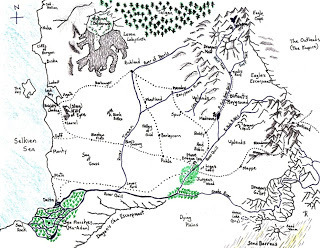
The stories all started with place. What if in this place a particular character had this conflict? What would happen? One short story begins off the map, to the south, and then moves onto the map. It also takes place two generations prior to Glimmer and The Stone Dragon. Another takes a character from The Stone Dragon and writes about that character prior to the novel. A third considers one reality of the fantasy novel--magical elemental water spirits--and explores the relationship of the season of the year to the behavior of the elemental spirits. All are set in specific places from the Dragons of Blood and Stone series: the Sand Barrens, The Easypeace River, and the Castle Madrone.
Having a reality with which one is familiar can both enrich one's writing and also inspire one's writing. I have more stories to tell. One is about a selkie at Seal Rock. Another is about rock gnomes and a young man named Cobb. I'm also waiting for a place name on the map to whisper to me an unexpected character and conflict.
Rosanne must know all about this. Her book Counting Churches, The Malta Stories consists of thirteen stories. Counting her novels set in Malta, it's apparent that the island speaks to her, tells her its stories. I'm happy to read the Maltese stories that Rosanne tells.
And I'm also happy to explore the fantasy reality of The Stone Dragon, to learn its stories and to tell them to you.

Copyright 2012 by Thomas L. Kepler, all rights reserved
 Rosanne Dingli has published three works in which the island of Malta is of central importance: Counting Churches, The Malta Stories; Death in Malta; and her most recent work, Camera Obscura. Perhaps the old truism Write about what you know applies to Rosanne because she was born and raised on Malta, living there until she was twenty-seven years old. I'm guessing it's more than that, though. A familiar setting cannot only supply compelling detail for a story: a setting can also suggest compelling stories to a writer.
Rosanne Dingli has published three works in which the island of Malta is of central importance: Counting Churches, The Malta Stories; Death in Malta; and her most recent work, Camera Obscura. Perhaps the old truism Write about what you know applies to Rosanne because she was born and raised on Malta, living there until she was twenty-seven years old. I'm guessing it's more than that, though. A familiar setting cannot only supply compelling detail for a story: a setting can also suggest compelling stories to a writer.Rosanne has asked that I write a guest post, and setting seems appropriate, since Rosanne has used it to such great effect. I write fantasy and have published a fantasy novel, The Stone Dragon . The story came to me one Thanksgiving vacation: dragons, gnomes, and a protagonist called Glimmer. I started writing, and suddenly I was seven thousand words into the novel, which is now available in both print and e-formats. This reality has grown to include a sequel in draft version, Dragons of Blood and Stone, and short stories published as an e-book Who Listened to Dragons, Three Stories .
I drew a map to aid me in the writing of The Stone Dragon, and that map grew and filled itself in as I wrote the first draft of Dragons of Stone and Blood. A funny thing then happened regarding that map. During this last winter vacation (I'm a school teacher in America), I wrote several short stories that were set in the fantasy reality of the novels.

The stories all started with place. What if in this place a particular character had this conflict? What would happen? One short story begins off the map, to the south, and then moves onto the map. It also takes place two generations prior to Glimmer and The Stone Dragon. Another takes a character from The Stone Dragon and writes about that character prior to the novel. A third considers one reality of the fantasy novel--magical elemental water spirits--and explores the relationship of the season of the year to the behavior of the elemental spirits. All are set in specific places from the Dragons of Blood and Stone series: the Sand Barrens, The Easypeace River, and the Castle Madrone.
Having a reality with which one is familiar can both enrich one's writing and also inspire one's writing. I have more stories to tell. One is about a selkie at Seal Rock. Another is about rock gnomes and a young man named Cobb. I'm also waiting for a place name on the map to whisper to me an unexpected character and conflict.
Rosanne must know all about this. Her book Counting Churches, The Malta Stories consists of thirteen stories. Counting her novels set in Malta, it's apparent that the island speaks to her, tells her its stories. I'm happy to read the Maltese stories that Rosanne tells.
And I'm also happy to explore the fantasy reality of The Stone Dragon, to learn its stories and to tell them to you.

Copyright 2012 by Thomas L. Kepler, all rights reserved
Published on April 24, 2012 03:04
April 21, 2012
Students Plant Trees at Maharishi School during Earth Day Weekend

"I was really disappointed last year when so many trees were cut down to prevent the spread of disease. Ever since I was born, I can remember how unique and amazing our school was with all of its trees, and I'm excited to see that the beauty will be restored," said Maharishi Boys' School senior Thomas Weiss after an afternoon filled with tree planting yesterday (second from right in photo above).
Maharishi School students, grades 1-12, as a part of Earth Day weekend activities and Alliant Energy's "Hometown Rewards Program," planted 34 trees on the school grounds.
"On Monday, April 16, Emily Swihart of 'Trees Forever,' and Scott Timm, Fairfield’s Sustainability Coordinator, gave a presentation to our enthusiastic Middle and Upper School students, as well as our 5/6 graders, and explained how trees impact energy usage," the weekly Maharishi School newsletter stated on Friday. The program is part of Alliant Energy's program to provide funds "to plant trees to help with energy efficiency, biodiversity, and carbon off-setting."
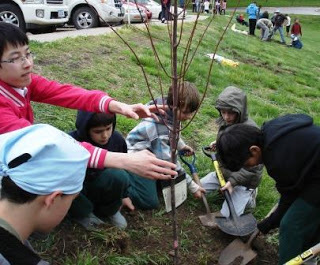
On a cool and overcast day, students in all grades, 1-12, were divided into seventeen groups, the younger students assisting while the older students provided leadership. Digging holes, planting, watering, and mulching the trees were the tasks of each group. Trees were planted at the Nature Explore Classroom, the parking meridian loop at the school's east entrance, edging the schools soccer and PE field, at the upper playground on the hill above the soccer field, and near the student parking lot.

Copyright 2012 by Thomas L. Kepler, all rights reserved
Published on April 21, 2012 07:56
April 19, 2012
The Pleasure of Reading

I'm re-reading right now C.J. Cherryh's thirteen-plus books in her Foreigner science fiction book series. It's a strategy for me to take it easy after my winter pneumonia experience. The thirteenth book is her new addition to the series, Intruder , which I am looking forward to reading.
By the time I finish this series, the school year will be over, and I will be ready to focus on my writing again. (Hopefully sooner, actually!)
My main observation about the above photo is that the woman is reading an actual paper book rather than an electronic edition of the book on an e-reader. What a Romantic concept!
Copyright 2012 by Thomas L. Kepler, all rights reservedImage from pinterest.com
Published on April 19, 2012 04:04
April 15, 2012
New Adventures for Gulliver on His Travels from Maharishi School Students
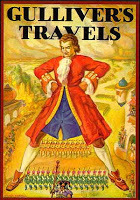 Students at Maharishi School taking the British Literature course were assigned to write a "new adventure" for Gulliver's Travels.
Students at Maharishi School taking the British Literature course were assigned to write a "new adventure" for Gulliver's Travels. The three main criteria for the new adventure were as follows:
Story structure: beginning, middle, end (either as a story or synopsis); some conflict likely to fit the Age of ReasonChanging society: indication of weakness or imbalance in society; a solution is advancedProofreading: margin suggestions on D1 corrected on D2; correct submission formatHere are some examples.
New Island--by Raphael G.
Before Gulliver finally journeys home, he lands upon one final island. This island is inhabited by two battling and contradictory races, separated by one giant river running through the island.
The first of the two races that he meets is one called the Arthantians. These Arthantians are a race that believe in deities for everything. This first astonishes Gulliver because he is used to a monotheistic society, but later he accepts the fact that they are entitled to their own opinion and that to them this seemingly outdated belief makes sense in its own context. He also starts to witness the Arthantians are very fat and slow because they are always waiting for things to happen, because they believe that there are greater beings watching over them and doing all the work for them. This leads to many of the Arthantians to become hungry and start to get weak because of a lack of them performing actions for themselves.
After spending some time with this new race, he later comes across another race when he is sent down to the central river to go fishing. This race captures him, and takes him as a captive thinking that he is a member of the Arthantians. This race that captures him is called the Platonites, and they are a race that believes solely on what can be proven through science and mathematics, and that all else is waiting to be proven or does not exist. These Platonites are the practically the opposite in appearance from the Arthantians in that they are very skinny and small and always moving. They are constantly building and creating things and are hardly getting sleep because of a ingrained need to discover new things.
This conflict in beliefs between the Arthantians and Platonites causes an ongoing battle. When Gulliver stays with the Platonites, he realizes that throughout the entire time of their existence the Arthantians have been trying to convert the Platonites, while at the same time then Platonites have been trying to destroy the Arthantians because they believe them to be less intelligent and inferior. In the end the Arthantians and the Platonites begin to fight across the central river and start to destroy each other’s villages.
Gulliver finally steps in after having spent time with both races and has a rather un-biased opinion, seeing as he personally does not subscribe to either of the two races beliefs. He gets them to stop fighting and put aside their differences after he explains that although the Arthantians and Platonites believe in different theories of existance, that this should not be a reason for violence and that they all have their own opinions and unless it causes harm, they are entitled to those beliefs.
The Island of Ness--by Avi M.
Through this island, Gulliver learns an important lesson about society. Civilization can not be so obsessed with ideas or the past, that they fail to put their resources into simply moving their society along the way it is. This is shown through the idea of the “Skelts” who could be working as farmers or other productive members of society, but instead are forced by the government to hunt through the ruins of the past with little or no useful purpose. Another lesson Gulliver learns through this island is how being obsessed with ideas or the past can lead to a society centered around fear resulting from the suffering in the society as a whole. This idea is shown through the religion of this society which is based around an “evil” god who hates them.
Before Gulliver finally journeys home, he lands upon one final island. This island contains the remains of a lost utopian society and the race known as the “Ness.” When he first washes up on the shores of the destroyed island, he is brought by the ness to the king’s palace and is treated like a god upon awakening. In fact, everyone is treats him like a god. The king of the “Ness” introduces himself to him by actually bowing before him.
Gulliver learns of the peoples past and discovers that the people believe he is someone from the “before times” who will help them unlock the secret to rebuild the perfect society. He also learns of their religion, in which they believe in an all powerful evil god, Bael, who caused the downfall of the previous society. While he was touring their capital city, built on the remains of the largest city in the “before times,” he witnessed the hundreds of thousands starving and disease-ridden “Skelts,” who work for the government hunting through the dangerous remains of old buildings from this island's past. The Skelts supposedly work to try to discover technology and the secrets that helped make the past society so great; however, they have barely found anything.
Gulliver suggests to the king that they put their efforts and resources more towards looking forwards for their future, instead of dwelling on the past. The king, in a fit of hysteria, declares that he must be a servant of Bael, sent to try to keep them from discovering the secrets of the great past and imprisons him in a dungeon. Gulliver breaks through the bars of the jail in the middle of the night and sneaks his way to the gates of the town. He is discovered by some of the king’s guards who chase him to the beach where he swims out to a small island. The next night he sneaks back and steals a small boat, and with no choice but to leave, sets off for home.
The Garrus--by Bryan P.
The Garrus are a race of blue individuals who spend their entire lives to support a single individual from their population. Unbeknownst to them, the individual is not in any way superior to anyone else, but because of tradition they think not to change their ways. Because of this everyone lives in poverty and without the basics to life.
To have an enlightened society the entire population must all be on the same level of existence. Gulliver is thrust into this new environment which symbolizes the world from which he came from a far more gross perspective.
Gulliver lands on a continent called Aria. On Aria he is met by a race of humanoid blue people who call themselves the Garrus. The Garrus then take Gulliver to their leader, who is lavishly treated with riches and material things which distinctly contrast with the state of their population, who lives in slums and in poverty.
As Gulliver explores this society, he finds that the individuals live under the the impression that they live in a fully utopian society. He discovers the fact that their entire ideology is based off of pleasing a single individual who is chosen by an extremely arbitrary system of behavioral observation and thus self-depriving the rest of the population from common luxuries. After talking to The Arterian, Gulliver realizes that there is not actually anything different between him and the rest of his people, but they were too stuck in their traditional ideology to make any changes.
Gulliver decides not to get involved in the socio-political issues of the nation after failing to convince anyone that they have the power and option to raise their standard of living, but before he can get away, the system of choosing makes him the next Arterian after the previous one has died after a small aneurysm. Gulliver is forced to take the high ranking position and, after being treated to all the luxuries of the world, finds his morality which makes him teach and thus release the population from their traditions of servitude.
Copyright 2012 by the respective writers, all rights reserved
Published on April 15, 2012 14:32
April 7, 2012
Remembering Before Revising: Dragons of Blood and Stone
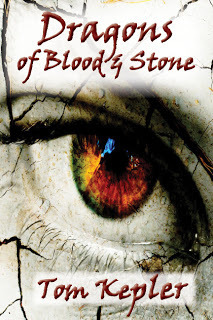
Hard to imagine, but it was in 2008 that I wrote the first draft of Dragons of Blood and Stone, the sequel to The Stone Dragon.
So why have I waited four years to revise? Well, I've learned how to publish and have three books out and one set of short stories--and I've learned a lot about how to market online.
The short stories are all set in the Dragons of Blood and Stone series universe and are published as an ebook: Who Listened to Dragons, Three Stories , for $ 0.99.
Now, after coming back from a bout with the flu virus and pneumonia, I'm ready to rewrite Dragons of Blood and Stone. After four years, though, I can't just jump in and rewrite it. To be perfectly honest, I don't even remember a lot of the details.
I remember some details:
two new dragons: Kubera, a dragon that has gotten too greedy and needs help; and Agnim, a dragon injured by dream magic and who wants to return to its lair of liquid stone and be left alonea woman whose magic attracts men like a bee gathers pollena . . . slug, a slug-like dragon that lives in a river and consumes travelers . . . ?a ghost, a madman, a scrier of cards, an army and a prophesy . . .It's all vague recollection--but tantalizing. Here is my plan of action.
 Buy HereI'm going to read my novel and write a synopsis of every chapter. Events, conflicts, characters. Then, based on my experience of writing and bringing to publication two novels and a set of short stories, I'll revise and rewrite.
Buy HereI'm going to read my novel and write a synopsis of every chapter. Events, conflicts, characters. Then, based on my experience of writing and bringing to publication two novels and a set of short stories, I'll revise and rewrite.I'm curious to consider the rough-cut stone of the novel, curious to find the gem that can emerge if my key strokes are deft enough. In the meantime, try out the short stories if you want a sample--ninety-nine cents for a little over twelve thousand words.
Copyright 2012 by Thomas L. Kepler, all rights reserved
Published on April 07, 2012 06:00
March 30, 2012
Alfred Hitchcock Defines "What Is Happiness?"
A good friend posted this video on Facebook of Alfred Hitchcock defining happiness.
Hitchcock defines happiness as being able to pursue the creative without having to cope with the negative and destructive. I find this a wonderful definition.
I am also reminded of a statement by Maharishi Mahesh Yogi, who introduced Transcendental Meditation to the world.
He said that even an enlightened individual can be influenced by the suffering of others--not overcome, but influenced. His analogy was that someone can be in the sunshine, and then the sun is dimmed by a cloud. The sun is still fully there, but its influence seems to be lessened. In that way, one totally full inside can be aware of the suffering of others--and I believe this is why so many people who are living obviously integrated lives of self-actualization use their creativity and energy to help others.
May we all live to spread the sunshine.
Copyright 2012 by Thomas L. Kepler, all rights reserved
Hitchcock defines happiness as being able to pursue the creative without having to cope with the negative and destructive. I find this a wonderful definition.
I am also reminded of a statement by Maharishi Mahesh Yogi, who introduced Transcendental Meditation to the world.
He said that even an enlightened individual can be influenced by the suffering of others--not overcome, but influenced. His analogy was that someone can be in the sunshine, and then the sun is dimmed by a cloud. The sun is still fully there, but its influence seems to be lessened. In that way, one totally full inside can be aware of the suffering of others--and I believe this is why so many people who are living obviously integrated lives of self-actualization use their creativity and energy to help others.
May we all live to spread the sunshine.
Copyright 2012 by Thomas L. Kepler, all rights reserved
Published on March 30, 2012 04:00
March 27, 2012
Book Review: Camera Obscura, by Rosanne Dingli
 The Mediterranean island of Malta is the key to Rosanne Dingli's novel Camera Obscura.
The Mediterranean island of Malta is the key to Rosanne Dingli's novel Camera Obscura.Compelling conflicts and intrigue, centering around computer hacking and art theft, balance the romantic interest of the book--but it is the incandescent pleasure of sunlight illuminating the island and people of Malta that made this novel memorable, descriptions of "the rubble walls, carob trees, vines and climbers spilling over the tops of walls that evidently concealed small gardens."
The island becomes a significant presence, providing an alternative to the frenetic pace of life captured at the beginning of the novel. Malta is timeless earth-stability, the alternative. "There was a terraced tessellation of fields below, each bounded by a long serpentine limestone wall, which stretched for some of the way beneath their hotel window. There was limestone everywhere: flat-topped houses ahead, spires and belfries of churches that pinned the landscape in place under scudding clouds."
The main character, Australian photographer Bart Zacharin, was a challenge for me at the beginning of the novel--a self-absorbed individual with issues stemming from his growing up, a guy who makes the wrong decisions for the wrong reasons. Following his attraction to the mysterious Minnie Cuff, he travels from Australia to France to Malta, seeking self-knowledge, understanding, and love. The novel's action and Zacharin's journey to Malta are, in a sense, the man's journey to his own potential.
It is on Malta where he finds himself and resolves many of his issues. It is the healing effects of the island and its people that provided the incentive to continue reading and to learn to appreciate Zacharin. I'm glad I stuck with it.
Minor characters on Malta--his father's lover, a painter, a gardener/medical doctor, a chief of police--were, for me, among the most interesting aspects of the novel. Their influence on Zacharin create a dynamic, along with the physical island's influence, that allowed an appreciation of Zacharin's quest.
Here is a bit about Stella De Cortis, Zacharin's father's life-long love: "Suddenly, looking at her in her huge house with its walls like ramparts, her garden that was scented with Mediterranean blooms, he felt what his father must have felt there. Sanctuary: peace. She was the embodiment of comfort, of affection, without artifice or rancour, and had taken Charles [the father] on trust, not demanding for a minute that he change or mutate to her demands. If only everyone were that accepting and that trustful."
Malta provides a blend of antiquity and the contemporary, and it is in Malta that Zacharin learns about the father who abandoned him, where he begins to make decisions about his life rather than just reacting to the stimuli of the environment about him. The ancient island that is also modern--cameras and the reality of the image, his father's journals and the reality of the words, his father's contemporaries and their gentle suggestions--Dingli's Camera Obscura is the journey of an unformed, dependent personality trudging to self-actualization. It is a well-formed blend of thrilling action and suspense with character development.
I've read other works by Rosanne Dingli and expected a well-written novel that was fulfilling on several levels. I wasn't disappointed. If, like me, you find Bart Zacharin a dull boy at the beginning, stick with it. Forgive the caterpillar and celebrate the butterfly. It is the caterpillar which makes the latter butterfly so much more significant.
Copyright 2012 by Thomas L. Kepler, all rights reserved
Published on March 27, 2012 09:32
March 26, 2012
The Stone Dragon Showcased at Bargain eBooks
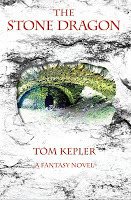
Bargain eBooks, a blog hosted by Holly Hook, features every 24 hours an ebook priced at $5 or below.
The Stone Dragon is bargain ebook #500.
"The author makes the point that magic is everywhere, in us, and around us, and at the core of everything . . . The dragons, of course, steal the show." --Pauline Ross, Goodreads review
Also consider an ebook of three short stories set in The Stone Dragon universe, Who Listened to Dragons, Three Stories, priced at $0.99.
Copyright 2012 by Thomas L. Kepler, all rights reserved
Published on March 26, 2012 12:16
March 16, 2012
Two Book Reviews: Tom Sawyer Abroad and Tom Sawyer, Detective
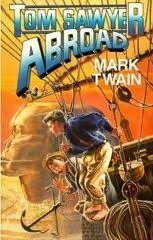 So it seems that Mark Twain wrote for books about the boys.
So it seems that Mark Twain wrote for books about the boys.The Adventures of Tom Sawyer (1876)The Adventures of Huckleberry Finn (1884)Tom Sawyer Abroad (1894)Tom Sawyer, Detective (1896)All four of these novels are available as free ebooks at Project Gutenberg.
I'm glad I read the last two novels and feel I've "completed my studies." My evaluation of the last two novels are that they involve Tom, Huck, and Jim in the same humorous relationship we see in the first two novels: the three discussing the nature of the world with both prodigious ignorance and unshakable homespun wisdom.
The difference between the first two and last two novels is that the humorous banter is all the latter have going--and it's not enough. The basic plot lines: a hot air balloon ride and a murder trial, are not carefully enough developed to justify the side journeys of philosophy from the boys.
I'm glad I read the two novels, though. They're quick reads that are not diminished by skimming. Tom Sawyer, Detective, provides an interesting introduction to The Tragedy of Pudd'nhead Wilson, Twain's last novel, which is also a murder mystery.
I suppose even Mark Twain is allowed a few "pot-boilers."
Copyright 2012 by Thomas L. Kepler, all rights reserved
Published on March 16, 2012 08:41



